Are you tired of dealing with difficult customers on a daily basis? Whether they're complaining about a product or service, making unreasonable demands, or just being outright rude, it can be a real challenge to handle these situations while you try to focus on your core business functions.
The way in which you handle difficult customers can have a significant impact on the success of your business. By addressing their concerns skillfully, you may foster trust and establish yourself as a trusted resource for customer service. On the other hand, if not handled correctly, it may result in loss of customers to your competitors.
In this comprehensive guide, we'll provide you with the tools and strategies you need on how to deal with difficult customers in a calm, professional, and effective manner. From understanding various types of difficult customers to responding to them effectively, we'll cover it all to help you turn even the most difficult customer into a satisfied one.
What are the 6 main types of difficult customers?

There are different ways to categorize difficult customers, but one common method is to divide them into six types:
Angry customer
An angry customer is someone who is upset and may express their dissatisfaction in a confrontational or aggressive manner. They may raise their voice, use strong language, and make accusations or demands. They may also be unwilling to listen to reason or to hear your explanation.
How do you handle angry customers?
To handle an angry customer, it's important to:
- Remain calm, composed and professional.
- Listen actively and empathize with their feelings.
- Acknowledge and apologize for any inconvenience they may have experienced.
- Avoid becoming defensive or argumentative
- Refrain from using strong language
- Offer a solution to the problem and provide options if possible
What would you say to an angry customer?
Here are a few examples of responses you could say on how to deal with difficult customers like the angry ones:
1. "I understand that you're upset. I'm sorry for any frustration you're experiencing. Can you tell me more about the problem so I can help you find a solution?"
2. "I apologize for the mistake. Can you please tell me more about what happened so we can resolve the issue together?"
3. "I understand that you're not happy with the service you received. I apologize for the inconvenience and would like to help you find a solution, can you please tell me more about the problem?"
4. "I apologize for the inconvenience you are experiencing. Can you please tell me more about the issue and what you would like to happen, so we can work together to find a solution?"
5. "I understand that you're upset. I'm sorry for any frustration you're experiencing. Please tell me more about the issue, so we can figure out the best way to help you."
Demanding customer
The "Demanding" customer could have high standards and make unreasonably high demands. It's crucial to establish firm boundaries with demanding customers while also being aware of their goals and understanding how to accommodate them. Give them information or choices that can aid in decision-making, and let them know whether or not their request can be fulfilled.
How do you handle demanding customers?
Handling demanding customers can be a challenging task, but there are several strategies that can be effective in managing the situation. Some strategies include:
- Remain calm and professional at all times.
- Listen actively to the customer's concerns and needs.
- Acknowledge and validate the customer's feelings.
- Take ownership of the problem and actively work to find a solution.
- Communicate clearly and transparently with the customer about what you are doing to resolve the issue.
- Keep your customer informed about the progress of their request and the expected resolution time.
- Follow up with the customer to ensure that their needs have been met and that they are satisfied with the outcome.
- Document the incident for future reference, and use the information to improve your service or processes.
- Don’t take it personally, always try to see things from the customer perspective and understand their position.
- Seek feedback and be open to suggestions for improvement.
What would you say to a demanding customer?
Here are a few sample scripts that you can use if you’re unsure on how to deal with difficult customers like the demanding ones:
1. "I understand that you're feeling frustrated and upset about this situation. I want to help you find a resolution as quickly as possible. Can you tell me more about what's been going on?"
2. "I apologize for any inconvenience that you've experienced. I want to make sure we get this resolved for you as soon as possible. I'll take full responsibility for finding a solution and keeping you informed every step of the way."
3. "I understand your urgency and I'll do my best to resolve this issue as quickly as possible. I'll keep you informed and let you know when we'll have a resolution. Can I provide you a specific timeframe that you can expect an update from us? "
4. "I just wanted to check in and make sure that the issue has been resolved to your satisfaction. Is there anything else that I can assist you with? May I ask for your feedback on how we handled the situation and what we could have done differently? We are continuously trying to improve our service."
5. "I understand what you're requesting, and I'll do my best to help you. However, I want to make sure that you have realistic expectations about what we can accomplish. Based on what you've shared with me, it seems that the request might not be possible with our current limitations, let me see if we could offer you an alternative solution."
Impatient customer
An impatient customer is someone who expresses a strong sense of urgency or frustration with the pace of service or the handling of their request. They may be easily irritated by delays or perceived inefficiencies, and may communicate this through their words, tone of voice, or body language. They may also have a tendency to be demanding or pushy in their interactions with customer service representatives.
How do you handle impatient customers?
Everyone struggles on how to deal with difficult customers like the impatient ones. Here are a few tips for effectively managing them:
- Remain calm and professional at all times, even if the customer is agitated or upset.
- Acknowledge and validate the customer's feelings, and let them know that you understand their urgency.
- Let them know that you are doing everything you can to resolve the issue as quickly as possible.
- Communicate clearly and transparently with the customer about what you are doing to resolve the issue and the expected resolution time.
- Actively listen to the customer's concerns and needs, and try to understand their perspective.
- Keep the customer informed about the progress of their request and the expected resolution time.
- Be upfront about any delays or issues that may impact the resolution time.
- Prioritize the customer's request based on the urgency they have communicated.
- Remain patient and empathetic, avoid interrupting or talking over the customer.
- Follow-up with the customer to ensure that their needs have been met and that they are satisfied with the outcome.
- Use a calm and assertive tone of voice, Avoid getting defensive or aggressive.
- Use active listening skills, repeat back key information to confirm understanding and show empathy.
What would you say to an impatient customer?
Here are a few examples of what you could say to an impatient customer:
1. "I understand that you need this resolved as soon as possible. I am doing everything I can to handle your request as quickly as I can."
2. "I can understand that this must be frustrating for you. Please let me assure you that I am here to help and I will do my best to resolve the situation as soon as I can."
3. "I understand your urgency, and I'll do my best to resolve this issue as quickly as possible. Can I provide you with a specific timeframe for when you can expect an update or resolution?"
4. "I apologize for any delays you've experienced. I want to be transparent with you, there is an unexpected setback that is causing a delay on our end, but we are doing everything we can to resolve it as soon as possible. "
5. "I want to explain to you the actions we are taking to address your request. We are currently working on it and this is what I am doing to solve it. Can I give you a specific time frame when you can expect resolution? "
6. "I appreciate your patience on this matter, let me assure you that I am fully committed to resolving this issue for you. Is there anything else I can assist you with while we work to resolve this?"
Arrogant customer
An arrogant customer is someone who behaves in a self-important or superior manner, and can often be dismissive or condescending to customer service representatives. They may act as if they know more than the customer service representative, or have an expectation of preferential treatment. They may not be willing to compromise, expecting that their request to be fulfilled exactly as they want, regardless of whether it's realistic or not.
How to deal with arrogant customers?
Learning how to deal with difficult customers like the arrogant ones can be a difficult task, as they may not be receptive to traditional customer service techniques. Here are a few tips you can follow:
- Remain calm and professional at all times. Do not let the customer's behavior provoke an emotional response.
- Acknowledge and validate the customer's feelings, but do not allow their attitude to become the focus of the interaction.
- Speak in a calm and assertive tone, avoid getting defensive or aggressive.
- Keep the conversation focused on finding a solution, instead of getting into an argument or power struggle.
- Don't take the customer's attitude personally and maintain a professional demeanor. If the customer is unwilling to listen or cooperate, it's important to still stay calm and professional.
- Inform them that you are doing everything you can to help them, but that you may have to involve a supervisor or manager if necessary.
What would you say to an arrogant customer?
Here are a few sample scripts you can use when interacting with an arrogant customer:
1. "I understand that this is important to you, and that you have high expectations. Can you tell me more about what you're looking to achieve?"
2. "I apologize if there's been any confusion or inconvenience, I want to make sure I understand your needs and I'll do my best to help you resolve this issue as quickly as possible. Can I take ownership of this issue and keep you updated on the progress?"
3. "I understand your urgency, and I'll do my best to resolve this issue as quickly as possible. Can I provide you a specific timeframe for when you can expect an update from us?"
4. "I understand your request, and I'll do my best to help you. However, I want to make sure that you have realistic expectations about what we can accomplish. Based on what you've shared with me, this request is beyond the scope of our policy and limitation. Let me see if we could offer you an alternative solution that would still meet your needs."
5. "I understand your concerns, and I'm willing to help, however, let me advise you that I can only provide you with accurate and helpful information, If you insist on making unfounded accusations or being dismissive of our suggestions, it will be difficult for me to assist you effectively."
Uninformed customer
The "Uninformed" customer may lack knowledge about your product or service and may require additional education or information. To deal with an uninformed customer, it's important to be patient and provide clear and easily understandable information.
How do you deal with uninformed customers?
Dealing with uninformed customers can be challenging, as they may not be aware of the information or resources that are available to them. Here are a few tips for handling ignorant customers in a polite manner:
- Remain calm and professional at all times. Do not let the customer's lack of knowledge provoke an emotional response.
- Be patient and understanding, the customer may not have the same level of knowledge or experience as you.
- Speak in a clear and simple language, avoid using technical jargon or complex explanations.
- Provide the customer with clear and accurate information about the product or service, and any related resources.
- Use active listening skills, repeat back key information to confirm understanding and show empathy.
- Be proactive and offer additional resources, such as brochures, instructions, videos, or even follow-up calls, to help the customer understand better.
- If necessary, be willing to transfer the customer to someone with more expertise or another department that can assist them better.
What would you say to an uninformed customer?
Here are some sample responses you can use when interacting with an uninformed customer:
1. "I understand that you may not have all the information you need. I'll do my best to help you understand better."
2. "I understand that this might be new to you. Let me explain it to you in a simpler way."
3. "I understand that you might need more information. I'll send you a brochure or a video that can explain it better and help you understand it in more detail."
5. "I understand that you might have more questions, would you like me to schedule a follow-up call with you to make sure all your questions are answered and you are satisfied with our service?"
6. "I understand that you may have some questions or concerns. Is there anything else I can assist you with or explain better? I welcome any feedback or suggestions you have, it helps us to improve our service."
7. "Let me summarize what we have discussed so far, and please correct me if I misunderstood something. In this way, we can make sure that we are on the same page"
Passive-aggressive customer
A passive-aggressive customer is someone who expresses their dissatisfaction or frustration in a subtle, indirect, or non-verbal way. They may be difficult to read, as they may not express their feelings or complaints directly. They may use sarcasm, hints, or veiled criticisms, instead of expressing themselves openly and honestly. They may also use silence, avoidance, or procrastination as a way to express their dissatisfaction.
How to deal with passive-aggressive customers?
Dealing with passive-aggressive customers can be challenging, as their behavior may be difficult to identify and address. Here are a few pro tips for handling passive-aggressive customers:
- Pay close attention to the customer's tone, body language, and choice of words. They may be expressing their dissatisfaction indirectly.
- Try to clarify the customer's concerns by asking open-ended questions and actively listening to their responses.
- Acknowledge the customer's feelings, even if they are not expressed directly, and validate their concerns.
- Use active listening skills and try to summarize what the customer said, this can help you ensure you understand their concerns and also can help them to feel understood.
- Show empathy, understanding and kindness, even if the customer is not always easy to communicate with.
What would you say to a passive-aggressive customer?
If you don’t know how to deal with difficult customers like the passive-aggressive ones, then you may use the following effective responses to deliver a successful customer experience:
1. "I understand that something may not be going as you expected, can you please share more about your experience, so we can try to address your concerns?"
2. "I understand that you may be feeling disappointed or frustrated. Your concerns are important to us, and I want to help you find a resolution."
3. "I apologize that you have not been satisfied with our service. Can you please explain to me what specifically was the problem that you had, so we can address it directly?"
4. "I understand your concerns, and I'll do my best to help you. Can you let me know what would be the best solution for you? And Can you please provide me with your feedback on how we can improve our service for you in the future?"
5. "I understand that you may not be expressing your concerns directly. I want to help you, but I need you to be specific and direct in order to understand your concerns and offer a solution."
How do you answer a tricky customer question?
Tricky customer questions are those that are designed to test the knowledge or ability of the customer service representative, or to catch them off guard. These questions can come in many forms, such as those that are vague, hypothetical, or designed to confuse. They can also be confrontational or challenging, testing the representative's patience, or even trying to trip them up.
Customers may ask tricky questions for a variety of reasons. Some may be genuinely curious or seeking more information, while others may be testing the representative's knowledge or authority. Some customers may be unhappy with a product or service and may ask tricky questions as a way to express their dissatisfaction. Additionally, some customers may ask tricky questions out of frustration, a lack of understanding, or even to assert dominance.
To answer tricky customer questions effectively, you should:
- Remain calm, composed, and professional.
- Ask clarifying questions to fully understand the customer's concerns or inquiry.
- Research the answer or information if necessary, and provide accurate and complete information.
- Avoid becoming defensive or argumentative, even if the customer's questions or statements are confrontational.
- Encourage the customer to share their thoughts or feedback, and take their comments into account when finding a solution.
What are the 4 types of difficult customer answers?
There are several types of customer answers that can be difficult to address, but here are four common ones:
1. Vague or unclear answers: Some customers may provide vague or unclear answers when asked about their concerns or issues. This can make it difficult for the customer service representative to understand the problem or to provide an effective solution.
2. Non-responsive answers: Some customers may not respond to the customer service representative's questions or comments, making it difficult to continue the conversation or to address the issue at hand.
3. Hostile or aggressive answers: Some customers may become hostile or aggressive when interacting with a customer service representative. This can make it difficult for the representative to address the issue and may escalate the situation.
4. Demanding or unrealistic answers: Some customers may have unrealistic or demanding expectations of the customer service representative, or of the company. This can make it difficult to find a solution that meets the customer's needs while also adhering to company policies or limitations.
It's important to keep in mind that customers may have many reasons for giving these types of answers. To avoid common mistakes in customer service, it can be helpful to try to understand customers’ needs and to respond with empathy and professionalism.
How to deal with difficult customers — Hire the best customer support agents!
Is handling difficult customers consuming most of your valuable time and financial resources? Then outsource your customer service needs to a reliable outsourcing service provider. Hire world-class customer support agents and increase your customer satisfaction and drive repeat business.
Consider ManilaPros, a leading full-service outsourcing provider in the Philippines that offers five-star customer care for retailers. We'll provide you with vetted and trained customer support agents who are more than qualified in delivering high-quality customer service.
Book a call with us today to learn more about our service.




